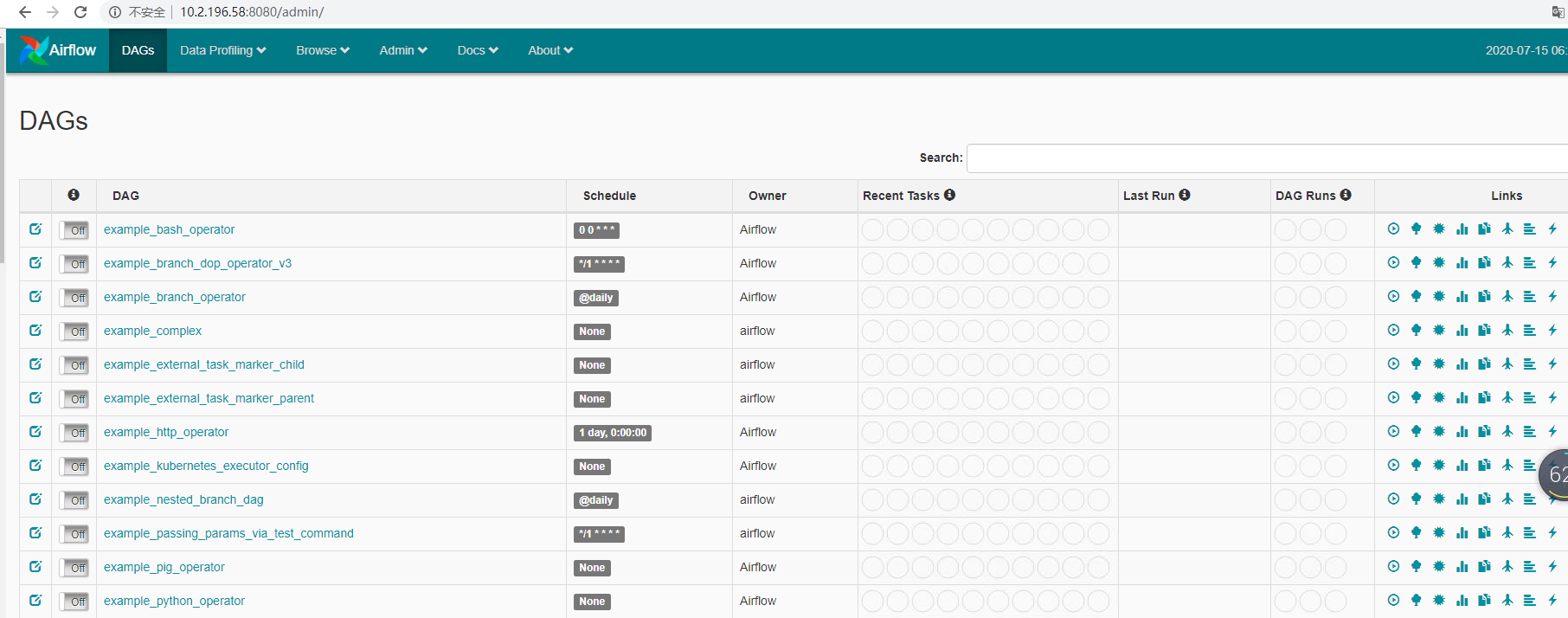airflow(一)centos7安装airflow
环境准备
1.conda创建虚拟环境
conda create -n 虚拟环境名字 python=版本
conda ccreate -n python3.6 python=3.6
2.查看虚拟环境
conda info -e
3.切换环境
Linux: source activate your_env_name(虚拟环境名称)
Windows: activate your_env_name(虚拟环境名称)
source activate python3.6
4.关闭环境
Linux: source deactivate
Windows: deactivate
安装airflow
1.升级pip
pip install --upgrade pip
2.安装gcc(有不用安装)
yum -y install gcc gcc-c++ kernel-devel
3.安装依赖
pip3 install paramiko yum -y install zlib-devel bzip2-devel openssl-devel ncurses-devel sqlite-devel readline-devel tk-devel gdbm-devel db4-devel libpcap-devel xz-devel
4.安装airflow
pip3 install apache-airflow
5.安装pymysql
pip3 install pymysql
6.配置环境变量
# vi /etc/profile #airflow export AIRFLOW_HOME=/opt/airflow # source /etc/profile
7.初始化数据库表(默认使用本地sqlite数据库)
airflow initdb
会在配置的airflow环境下生成如下文件
ls /opt/airflow airflow.cfg airflow.db logs unittests.cfg
8.配置MySQL数据库
创建airflow数据库,并创建用户和授权,给airflow访问数据库使用
如果没有mysql查看之前的笔记 linux安装mysql
mysql> CREATE DATABASE airflow; Query OK, 1 row affected (0.00 sec) mysql> GRANT all privileges on root.* TO 'root'@'localhost' IDENTIFIED BY 'root'; ERROR 1819 (HY000): Your password does not satisfy the current policy requirements #这个错误与validate_password_policy的值有关。默认值是1,即MEDIUM,所以刚开始设置的密码必须符合长度,且必须含有数字,小写或大写字母,特殊字符。 有时候,只是为了自己测试,不想密码设置得那么复杂,譬如说,我只想设置root的密码为root。 必须修改两个全局参数: 1)首先,修改validate_password_policy参数的值: mysql> set global validate_password_policy=0; Query OK, 0 rows affected (0.00 sec) #这样,判断密码的标准就基于密码的长度了。这个由validate_password_length参数来决定。 mysql> select @@validate_password_length; +----------------------------+ | @@validate_password_length | +----------------------------+ | 8 | +----------------------------+ 1 row in set (0.00 sec) 2)修改validate_password_length参数,设置密码仅由密码长度决定。 mysql> set global validate_password_length=1; Query OK, 0 rows affected (0.00 sec) mysql> select @@validate_password_length; +----------------------------+ | @@validate_password_length | +----------------------------+ | 4 | +----------------------------+ 1 row in set (0.00 sec) mysql> GRANT all privileges on root.* TO 'root'@'localhost' IDENTIFIED BY 'root'; Query OK, 0 rows affected, 1 warning (0.35 sec) mysql> FLUSH PRIVILEGES; Query OK, 0 rows affected (0.01 sec)
9.更改数据库配置
mysql> set @@global.explicit_defaults_for_timestamp=on;
10.配置airflow
vim airflow/airflow.cfg # The executor class that airflow should use. Choices include # SequentialExecutor, LocalExecutor, CeleryExecutor, DaskExecutor, KubernetesExecutor #executor = SequentialExecutor executor = LocalExecutor # The SqlAlchemy connection string to the metadata database. # SqlAlchemy supports many different database engine, more information # their website #sql_alchemy_conn = sqlite:////data/airflow/airflow.db sql_alchemy_conn = mysql+pymysql://root:root@localhost:3306/airflow
执行器executor 有如下选择
SequentialExecutor:单进程顺序执行任务,默认执行器,通常只用于测试
LocalExecutor:多进程本地执行任务
CeleryExecutor:分布式调度,生产常用
DaskExecutor :动态任务调度,主要用于数据分析
11.再次初始化数据库表
airflow initdb
12.查看创建的airflow数据表
mysql> use airflow;
mysql> show tables;
13.启动服务
airflow webserver
airflow scheduler
后台运行
# 打开airflow的webserver UI,为了使其后台运行,这里用了nohup
nohup airflow webserver -p 8080 > /opt/airflow/webLog.log 2>&1 &
# 打开airflow的调度器,以开始定时执行任务
nohup airflow scheduler > /opt/airflow/schedulerLog.log 2>&1 &
kill 进程
ps -ef|grep "airflow "|grep -v grep|cut -c 9-15|xargs kill -9
注释
"grep -v grep"是在列出的进程中去除含有关键字"grep"的进程。
"cut -c 9-15"是截取输入行的第9个字符到第15个字符,而这正好是进程号PID。
"xargs kill -9"中的xargs命令是用来把前面命令的输出结果(PID)作为"kill -9"命令的参数,并执行该令。
启动scheduler时如果出错
failed to log action with (sqlite3.operationalerror) no such table log
export AIRFLOW_HOME=/opt/airflow
airflow initdb
参考 点这里
14.浏览器查看

参考 点这里


